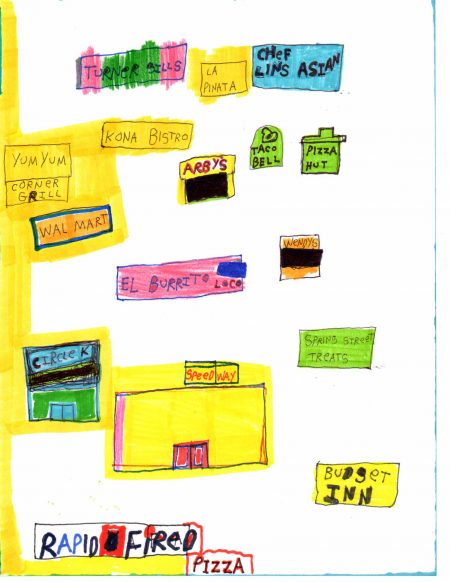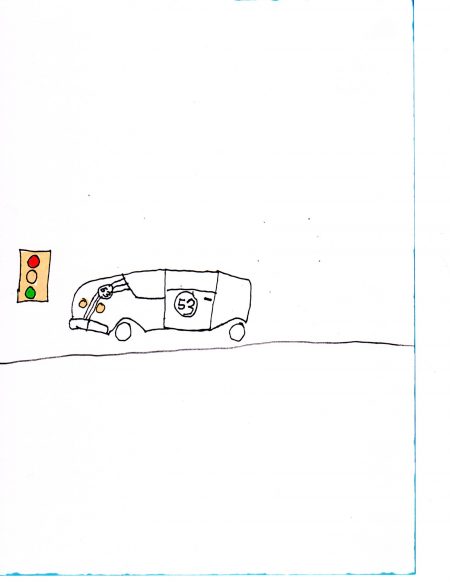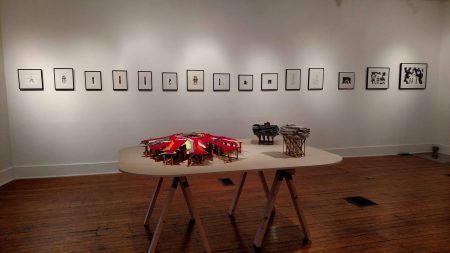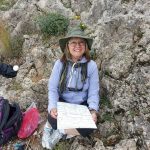
The story of the founding of the Raymond Thunder Sky Gallery and Visions and Voices Gallery, both in Northside, is as compelling as the art that is featured in these spaces.
Keith Banner and Bill Ross are the founders of both galleries; both of whom are visionaries, humanitarians, social workers and tireless supporters of art therapy. Their careers in social work provided the foundation and trajectory for this life work. Local Cincinnati artist Raymond Thunder Sky was in Bill Ross’ first caseload and when Bill discovered that Raymond made artwork, things began to click. This is all highly abbreviated, but before long, he and Keith Banner recognized the need for artists with disabilities to have a “safe place to create” in Bill’s words. So began Visionaries + Voices whose “mission is to provide artistic, cultural, and professional opportunities for artists with disabilities.”
“Raymond Thunder Sky is one of the most surprising and visionary artists to ever walk the streets of Cincinnati,” according to the press materials. A lot of Cincinnatians remember a man dressed in a clown collar and construction hat, walking the Cincinnati streets with a toolbox in tow, a serious expression on his face. He did this for many years, mystifying folks as to what he was up to. The man’s name was Raymond Thunder-Sky. And what he was doing was drawing demolition and construction sites throughout Cincinnati and other parts of the region. Raymond, a Native American with a rich family history, passed away in 2004, leaving behind over 2,000 drawings, and a vast array of clown costumes, construction hats, and toolboxes. His work is now collected internationally, and has been in gallery and museum exhibits across the world. Thunder-Sky, Inc. was founded in order to preserve Raymond’s legacy through exhibits and programs, and to provide an exhibition space and ongoing support for other unconventional artists in the area.”
Thunder-Sky’s art provides the lens through which Banner and Ross, the2. curators, select artists to exhibit in the gallery. Artists may be self-taught, like Ben Clark, or like two of the artists in Otherwise, are trained professionals. Both Nickolson and Benjamin are art professors as well. Yet together, the exhibition is a delight. The curators look for art work that is, quite simply, unconventional.

Self-taught artist Ben Clark’s crisp, brightly colored drawings and paintings take up two walls of the gallery space. Clark is in a program for disabled artists in Hamilton, Ohio. Keith Banner discussed Clark’s autobiographical approach to his art making: “Ben lives every day as a visually-inspired person and conveys his world to us with a natural sophistication.” Ben’s world consists of views of Wendy’s, or Ben’s favorite pizza parlor, or a whole block of stores, all crisply drawn with markers in dazzling colors. Some drawings are packed with information, while others, such as a car and a stop sign, are done with such economy of line as to be almost Japanese in its sparseness and use of white space. Clark is a natural.

In contrast, Richard Nickolson makes small, intense black and white drawings of things we overlook, things we don’t want to see. Nickolson zeroes in on a cel phone tower or power station smokestack. The drawings are elegant; the subjects are the pieces of urban junk we have to live with. He makes them interesting with the way he crops the objects and orients them carefully within very small formats that are carefully gridded in light pencil. A section of Alcatraz is depicted in a 5 ½ by 2 inch drawing. A group of Tower drawings range from 3 by 4 inches to 9 by 5 inches. Occasionally there is a delicate red mark, usually a simple line helping to grid off the space. The perfect pencil gridding and the black forms intensely rendered in a deliberately modest format draw the viewer in.

The third artist, Keith Benjamin, makes sculptures that animate the center of the gallery. They have the same delight with form making that is evident in Clark’s drawings and paintings. Benjamin takes the detritus of family living, collars from outgrown kids’ cotton t-shirt and voila! a circus-like merry-go-round of sorts is born, called Collar Fragments. Boxes left over from snacks become part of the cardboard girding of the sculptures. The sculptures are exploding with wit, snack boxes carefully cut or folded to provide just enough support for outgrown khaki pant fragments (Khaki.) Like the other two artists, Benjamin applies just the right touch, neither too little nor too much. He does not take his world for granted; the contents of his family life provide poignant material for sculpture making. Not Art Povera exactly, nor Surrealist shocking juxtapositions, like the fur-lined tea cup of Meret Oppenheim, but with the same spirit as made Kurt Schwitters take the torn ticket stubs from his coat pocket and say, “I can make interesting art from this.” Otherwise: Keith Benjamin, Ben Clark, Richard Emery Nickolson” opened April 8 and closes June 2, 2017.
In their Homepage is described “the active studio and gallery space of Visionaries and Voices, artist with disabilities make artwork that is often featured in the gallery. Currently, UNCANNY “is a portraiture show that seeks to visually convey the essence of the subject rather than solely the external appearance. An uncanny feeling of uncertainty occurs when viewing alterations or illusions of that which is real. The Uncanny exhibition at V+V questions our preconceptions on what is real and how we represent reality.”
Over 140 local artists attend the V+V studios. They use all manner of materials and this is evident in this portrait exhibit. There are acrylic portraits on canvas, paintings on found panels, on paper, even on post-it notes. The exhibit is fun. A large number of the artists in the program have their artwork in this exhibit so it has a democratic feel to it. The exhibit is uneven, as you would expect.
Past the gallery, which is in the front of the space, are the working studios of the artists with disabilities and their teachers. More portraits done by the artists were hung more informally on the walls of the studio space, which is a nice large room with lots of tables and generous working space. It had a great vibe. I am thrilled it exists and that these artists can create in a safe space. Thanks to Keith Banner, Bill Ross and the benefactors, granting agencies, educators and friends who make it possible. The exhibition runs until May 25, 2017. Gallery hours are MTWF 9am-4pm and Thursdays 9am-8pm
The artist for which ThunderSky Gallery is named has a posthumous retrospective at the Carnegie Arts Center, Covington, Kentucky on view until June 10, 2017.
Cynthia Kukla is an artist and Professor Emerita living in Northern Kentucky.
